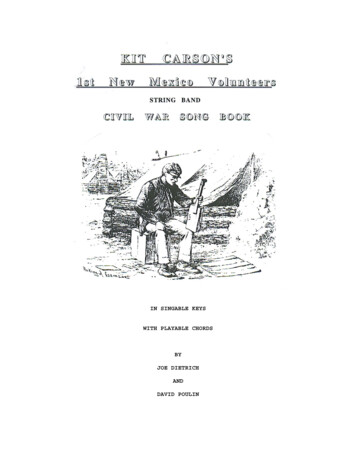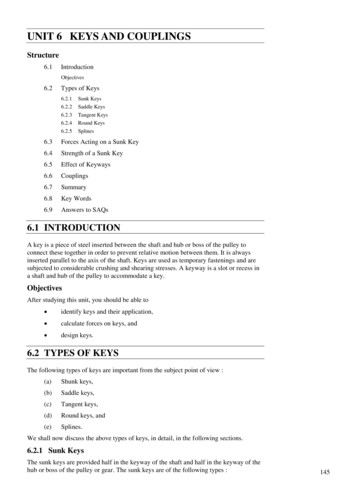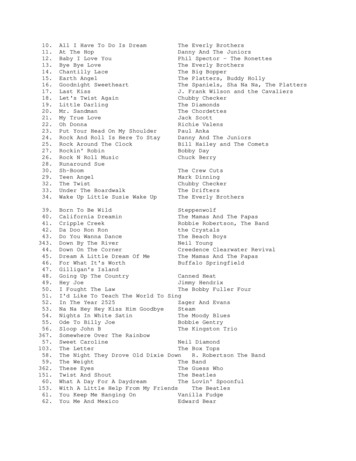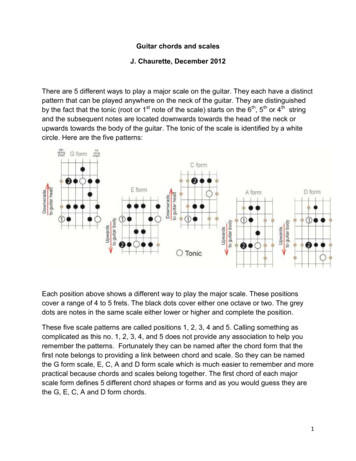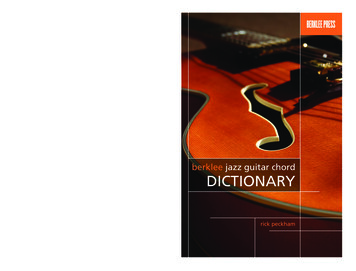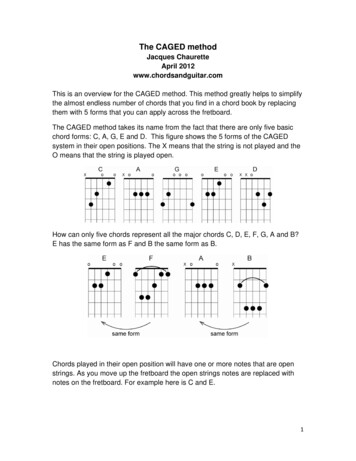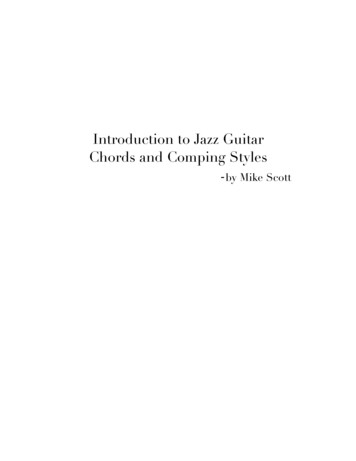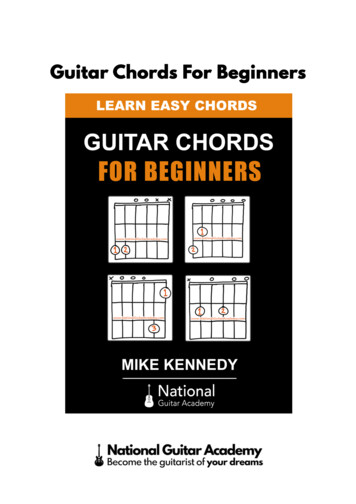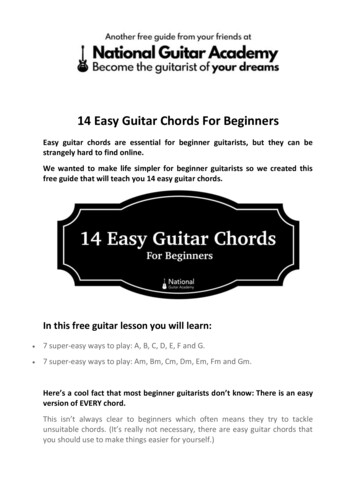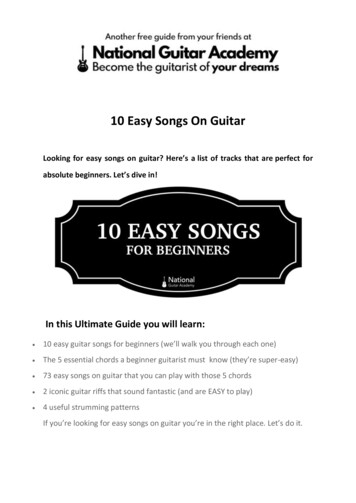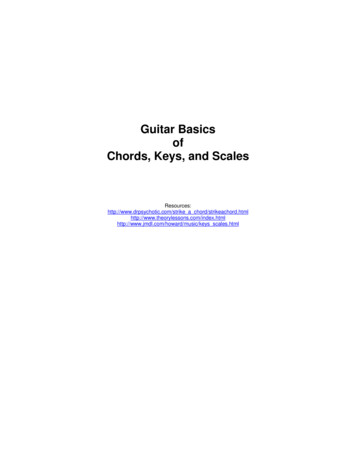
Transcription
Guitar BasicsofChords, Keys, and ScalesResources:http://www.drpsychotic.com/strike a m/index.htmlhttp://www.jmdl.com/howard/music/keys scales.html
Basic GuitarChords, Keys, and ScalesDecember 30th, 2004Table of ContentsThe Key of C .1The Basic chords in the key of C . 1Some substitute chords for the key of C. 1The Key of G.2The Basic chords in the key of G. 2Some substitute chords for the key of G . 3The Key of F .3The Basic chords in the key of F . 4Some substitute chords for the key of F . 4The Key of D .5The Basic chords in the key of D . 5Some substitute chords for the key of D. 6The Key of B flat .6The Basic chords in the key of B flat . 7Some substitute chords for the key of B flat . 7The Key of A .8The Basic chords in the key of A . 8Some substitute chords for the key of A. 9The Key of E flat .9The Basic chords in the key of E flat . 9Some substitute chords for the key of E flat . 10The Key of E .10The Basic chords in the key of E . 11Some substitute chords for the key of E. 11The Key of A flat .12The Basic chords in the key of A flat . 12Some substitute chords for the key of A flat . 13The Key of B .13The Basic chords in the key of B . 13Some substitute chords for the key of B. 14The Key of F# .14The Basic chords in the key of F# . 15Some substitute chords for the key of F# . 15The Key of D flat .16The Basic chords in the key of D flat . 16Some substitute chords for the key of D flat. 17Guitar Chord Progression .18Music Theory: Keys, Scales and Triads.18Minor keys. 19Enharmonic equivalents . 19Other keys. 20Relative minor and relative major keys. 20Key Signatures. 21Guitar Basics.23Basic Chord Chart - Guitar Chords and Finger Positions .24Five Positions of the Pentatonic Minor Scale.25The Art of Phrasing with Pentatonic Scales.26Transposing Scales into Other Musical Keys .27iii
Basic GuitarChords, Keys, and ScalesivDecember 30th, 2004
Basic GuitarChords, Keys, and ScalesDecember 30th, 2004The Key of CThis is the first section of what I hope will be a series of useful articles, designed to help thebeginner/intermediate guitarist learn guitar chords, as they apply to each given key. We startwith the key of C in this issue’s article. In music theory, the key of C is basically the center of thetonal universe, and therefore, a good place to start. Now everybody has a different method thatthey may apply when attempting to teach what I’m about to. If this doesn’t work for you, acceptmy apologies and don’t let it discourage you. If it does work for you, then my life will have hadsome meaning. Let’s start with the basic chords in the key of C.The Basic chords in the key of CChart 1Now let me explain the chord charts in case you don’t understand them. They represent theguitar neck, as you would look at it sideways. From right to left are the six strings of the guitarand the horizontal lines represent the frets. Got it? Good. Each finger is represented by anumber from 1-4, with 1 being the index finger, 2 being the middle finger, 3 being the ring fingerand 4 being the pinky. The "x" means that the string isn’t played, plucked, strummed or touched.Leave it alone! Whenever you see a line connecting the dots, it means that all of the dots arepressed down by the same finger. This is called “barring” the chord. Simplified: one finger laysacross the strings. Above, I’ve shown the basic chords for the key of C. Below are someadditional chords that I refer to as substitute chords.Some substitute chords for the key of CChart 2The above chart lists what are called substitute chords. Let’s say you played the first chordslisted in chart 1, in the order that they were listed. For the C major chord, you can substitute a Cmajor 7th chord. The D minor chord can be replaced by the D minor 7th chord. The same is truefor each of the remaining. Play them. Has a jazzy ring to it, doesn’t it? Some people refer to1
Basic GuitarChords, Keys, and ScalesDecember 30th, 2004substitute chords as orchestral chords but it doesn’t matter. A rose by any other name still has athorn. I’ve included additional substitute chords so that you can improve your chord vocabulary.You’ll be the life of the party and the envy of all your peers. You will be on your way to achievinggreatness. The sky is the limit. Let’s move on to some more substitute chords.Chart 3You may have noticed that most of the chord diagrams in chart 3 have a number to the left ofthem. Let’s use the Dm 9th as an example. The 5 to the left of the diagram means that the firstfret displayed is to be regarded as the fifth fret on your guitar.The Key of GWe started out with the key of C in the previous section. In this section we will cover thewonderful key of G. Let’s start with the basic chords in the key of G.The Basic chords in the key of GChart 4Now let me explain the chord charts in case you don’t understand them. They represent theguitar neck, as you would look at it sideways. From right to left are the six strings of the guitarand the horizontal lines represent the frets. Got it? Good. Each finger is represented by anumber from 1-4, with 1 being the index finger, 2 being the middle finger, 3 being the ring fingerand 4 being the pinky. The "x" means that the string isn’t played, plucked, strummed or touched.Leave it alone! Whenever you see a line connecting the dots, it means that all of the dots arepressed down by the same finger. This is called “barring” the chord. Simplified: One finger laysacross the strings. Above, I’ve shown the basic chords for the key of G. Below are someadditional chords that I refer to as substitute chords.2
Basic GuitarChords, Keys, and ScalesDecember 30th, 2004Some substitute chords for the key of GChart 5In the above chart is listed what are called substitute chords. Let’s say you played the firstchords listed in chart 1, in the order that they were listed. For the G major chord, you cansubstitute a G major 7th chord. The A minor chord can be replaced by the A minor 7th chord. Thesame is true for each of the remaining. Play them. Has a jazzy ring to it, doesn’t it? Somepeople refer to substitute chords as orchestral chords but it doesn’t matter. A rose by any othername still has a thorn. I’ve included additional substitute chords so that you can improve yourchord vocabulary. You’ll be the life of the party and the envy of all your peers. You will be onyour way to achieving greatness. The sky is the limit. Let’s move on to some more substitutechords.Chart 6You may have noticed that most of the chord diagrams in chart 3 have a number to the left ofthem. Let’s use the A minor 9th as an example. The 5 to the left of the diagram means that thefirst fret displayed is to be regarded as the fifth fret on your guitar.The Key of FWe ended our last section with the key of G. In this section we will cover the wonderful key of F.Let’s start with the basic chords in the key of F.3
Basic GuitarChords, Keys, and ScalesDecember 30th, 2004The Basic chords in the key of FChart 7Now let me explain the chord charts in case you don’t understand them. They represent theguitar neck, as you would look at it sideways. From right to left are the six strings of the guitarand the horizontal lines represent the frets. Got it? Good. Each finger is represented by anumber from 1-4, with 1 being the index finger, 2 being the middle finger, 3 being the ring fingerand 4 being the pinky. The “x” means that the string isn’t played, plucked, strummed ortouched. Leave it alone! Whenever you see a line connecting the dots, it means that all of thedots are pressed down by the same finger. This is called “barring” the chord. Simplified: Onefinger lays across the strings. You may have noticed that most of the chord diagrams in chart 1have a number to the left of them. Let’s use the G minor as an example. The 3 to the left of thediagram means that the first fret displayed is to be regarded as the third fret on your guitar.Okay? Above, I’ve shown the basic chords for the key of F. Below are some additional chordsthat I refer to as substitute chords.Some substitute chords for the key of FChart 84
Basic GuitarChords, Keys, and ScalesDecember 30th, 2004In the above chart, are listed what are called substitute chords. Let’s say you played the firstchords listed in chart 1, in the order that they were listed. For the F major chord, you cansubstitute an F major 7th chord. The D minor chord can be replaced by the D minor 7th chord.The same is true for each of the remaining. Play them. Has a jazzy ring to it, doesn’t it? Somepeople refer to substitute chords as orchestral chords but it doesn’t matter. A rose by any othername still has a thorn. I’ve included additional substitute chords so that you can improve yourchord vocabulary. You’ll be the life of the party and the envy of all your peers. You will be onyour way to achieving greatness. The sky is the limit. Let’s move on to some more substitutechords.Chart 9The Key of DIn this section we will cover the key of D. Let’s start with the basic chords in the key of D.The Basic chords in the key of DChart 10Now let me explain the chord charts in case you don’t understand them. They represent theguitar neck, as you would look at it sideways. From right to left are the six strings of the guitarand the horizontal lines represent the frets. Got it? Good. Each finger is represented by anumber from 1-4, with 1 being the index finger, 2 being the middle finger, 3 being the ring fingerand 4 being the pinky. The “x” means that the string isn’t played, plucked, strummed ortouched. Leave it alone! Whenever you see a line connecting the dots, it means that all of thedots are pressed down by the same finger. This is called “barring” the chord. Simplified: Onefinger lays across the strings. Above, I’ve shown the basic chords for the key of D. Below aresome additional chords that I refer to as substitute chords.5
Basic GuitarChords, Keys, and ScalesDecember 30th, 2004Some substitute chords for the key of DChart 11The chart above lists what are called substitute chords. Let’s say you played the first chordslisted in chart 1, in the order that they were listed. For the D major chord, you can substitute a Dmajor 7th chord. The E minor chord can be replaced by the E minor 7th chord. The same is truefor each of the remaining. Play them. Has a jazzy ring to it, doesn’t it? Some people refer tosubstitute chords as orchestral chords but it doesn’t matter. A rose by any other name still has athorn. I’ve included additional substitute chords so that you can improve your chordvocabulary. Let’s move on to some more substitute chords.Chart 12You may have noticed that some of the chord diagrams in the above chart have a number to theleft of them. Let’s use the B minor 9th as an example. The 7 to the left of the diagram meansthat the first fret displayed is to be regarded as the fifth fret on your guitar.The Key of B flatIn this section we will cover the key of B flat. Let’s start with the basic chords in the key of B flat.6
Basic GuitarChords, Keys, and ScalesDecember 30th, 2004The Basic chords in the key of B flatChart 13Now let me explain the chord charts in case you don’t understand them. They represent theguitar neck, as you would look at it sideways. From right to left are the six strings of the guitarand the horizontal lines represent the frets. Got it? Good. Each finger is represented by anumber from 1-4, with 1 being the index finger, 2 being the middle finger, 3 being the ring fingerand 4 being the pinky. The “x” means that the string isn’t played, plucked, strummed ortouched. Leave it alone! Whenever you see a line connecting the dots, it means that all of thedots are pressed down by the same finger. This is called “barring” the chord. Simplified: Onefinger lays across the strings. You may have noticed that most of the chord diagrams in chart 1have a number to the left of them. Let’s use the G minor as an example. The 3 to the left of thediagram means that the first fret displayed is to be regarded as the third fret on your guitar.Okay? Above, I’ve shown the basic chords for the key of B flat. Below are some additionalchords that I refer to as substitute chords.Some substitute chords for the key of B flatChart 14The chart above lists what are called substitute chords. Let’s say you played the first chordslisted in chart 1, in the order that they were listed. For the B flat major chord, you can substitutea B flat major 7th chord. The C minor chord can be replaced by the C minor 7th chord. The sameis true for each of the remaining. Play them. Has a jazzy ring to it, doesn’t it? Some people referto substitute chords as orchestral chords but it doesn’t matter. A rose by any other name stillhas a thorn. I’ve included additional substitute chords so that you can improve your chordvocabulary. You’ll be the life of the party and the envy of all your peers. You will be on your7
Basic GuitarChords, Keys, and ScalesDecember 30th, 2004way to achieving greatness. The sky is the limit. Let’s move on to some more substitute chords.Chart 15The Key of AThis is the 6th section of this article-designed to help the beginner/intermediate guitarist learnguitar chords, as they apply to each given key. We ended our last section with the key of B flat.In this section we will cover the wonderful key of A. Let’s start with the basic chords in the keyof A.The Basic chords in the key of AChart 16Now let me explain the chord charts in case you don’t understand them. They represent theguitar neck, as you would look at it sideways. From right to left are the six strings of the guitarand the horizontal lines represent the frets. Got it? Good. Each finger is represented by anumber from 1-4, with 1 being the index finger, 2 being the middle finger, 3 being the ring fingerand 4 being the pinky. The “x” means that the string isn’t played, plucked, strummed ortouched. Leave it alone! Whenever you see a line connecting the dots, it means that all of thedots are pressed down by the same finger. This is called “barring” the chord. Simplified: Onefinger lays across the strings. You may have noticed that most of the chord diagrams in chart 1have a number to the left of them. Let’s use the C# Minor as an example. The 4 to the left ofthe diagram means that the first fret displayed is to be regarded as the fourth fret on yourguitar. Okay? Above, I’ve shown the basic chords for the key of A. Below are some additionalchords that I refer to as substitute chords.8
Basic GuitarChords, Keys, and ScalesDecember 30th, 2004Some substitute chords for the key of AChart 17The chart above lists what are called substitute chords. Let’s say you played the first chordslisted in chart 1, in the order that they were listed. For the A major chord, you can substitute anA major 7th chord. The C# minor chord can be replaced by the C# minor 7th chord. The same istrue for each of the remaining. Play them. Has a jazzy ring to it, doesn’t it? Some people refer tosubstitute chords as orchestral chords but it doesn’t matter. A rose by any other name still has athorn. I’ve included additional substitute chords so that you can improve your chordvocabulary. Let’s move on to some more substitute chords.Chart 18The Key of E flatWe ended our last section with the key of A. In this section we will cover the key of E flat. Let’sstart with the basic chords in the key of E flat.The Basic chords in the key of E flatChart 199
Basic GuitarChords, Keys, and ScalesDecember 30th, 2004Now let me explain the chord charts in case you don’t understand them. They represent theguitar neck, as you would look at it sideways. From right to left are the six strings of the guitarand the horizontal lines represent the frets. Got it? Good. Each finger is represented by anumber from 1-4, with 1 being the index finger, 2 being the middle finger, 3 being the ring fingerand 4 being the pinky. The “x” means that the string isn’t played, plucked, strummed ortouched. Leave it alone! Whenever you see a line connecting the dots, it means that all of thedots are pressed down by the same finger. This is called “barring” the chord. Simplified: Onefinger lays across the strings. You may have noticed that most of the chord diagrams in chart 1have a number to the left of them. Let’s use the C Minor as an example. The 3 to the left of thediagram means that the first fret displayed is to be regarded as the fourth fret on your guitar.Okay? Above, I’ve shown the basic chords for the key of E flat. Below are some additionalchords that I refer to as substitute chords.Some substitute chords for the key of E flatChart 20The chart above lists what are called substitute chords. Let’s say you played the first chordslisted in chart 1, in the order that they were listed. For the E flat chord, you can substitute an Eflat major 7th chord. The C minor chord can be replaced by the C minor 7th chord. The same istrue for each of the remaining. Play them. Has a jazzy ring to it, doesn’t it? Some people refer tosubstitute chords as orchestral chords but it doesn’t matter. A rose by any other name still has athorn. I’ve included additional substitute chords so that you can improve your chordvocabulary. Let’s move on to some more substitute chords.Chart 21The Key of EWe ended our last section with the key of E flat. In this section we will cover the key of E. Let’sstart with the basic chords in the key of E.10
Basic GuitarChords, Keys, and ScalesDecember 30th, 2004The Basic chords in the key of EChart 22Now let me explain the chord charts in case you don’t understand them. They represent theguitar neck, as you would look at it sideways. From right to left are the six strings of the guitarand the horizontal lines represent the frets. Got it? Good. Each finger is represented by anumber from 1-4, with 1 being the index finger, 2 being the middle finger, 3 being the ring fingerand 4 being the pinky. The “x” means that the string isn’t played, plucked, strummed ortouched. Leave it alone! Whenever you see a line connecting the dots, it means that all of thedots are pressed down by the same finger. This is called “barring” the chord. Simplified: Onefinger lays across the strings. You may have noticed that most of the chord diagrams in chart 1have a number to the left of them. Let’s use the C# Minor as an example. The 4 to the left ofthe diagram means that the first fret displayed is to be regarded as the fourth fret on yourguitar. Okay? Above, I’ve shown the basic chords for the key of E. Below are some additionalchords that I refer to as substitute chords.Some substitute chords for the key of EChart 23The chart above lists what are called substitute chords. Let’s say you played the first chordslisted in chart 1, in the order that they were listed. For the E flat chord, you can substitute an Emajor 7th chord. The C# minor chord can be replaced by the C# minor 7th chord. The same istrue for each of the remaining. Play them. Has a jazzy ring to it, doesn’t it? Some people refer tosubstitute chords as orchestral chords but it doesn’t matter. A rose by any other name still has athorn. I’ve included additional substitute chords so that you can improve your chordvocabulary. Let’s move on to some more substitute chords.11
Basic GuitarChords, Keys, and ScalesDecember 30th, 2004Chart 24The Key of A flatWe ended our last section with the key of E. In this section we will cover the key of A flat. Let’sstart with the basic chords in the key of A flat.The Basic chords in the key of A flatChart 25Now let me explain the chord charts in case you don’t understand them. They represent theguitar neck, as you would look at it sideways. From right to left are the six strings of the guitarand the horizontal lines represent the frets. Got it? Good. Each finger is represented by anumber from 1-4, with 1 being the index finger, 2 being the middle finger, 3 being the ring fingerand 4 being the pinky. The “x” means that the string isn’t played, plucked, strummed ortouched. Leave it alone! Whenever you see a line connecting the dots, it means that all of thedots are pressed down by the same finger. This is called “barring” the chord. Simplified: Onefinger lays across the strings. You may have noticed that most of the chord diagrams in chart 1have a number to the left of them. Let’s use the C Minor as an example. The 3 to the left of thediagram means that the first fret displayed is to be regarded as the fourth fret on your guitar.Okay? Above, I’ve shown the basic chords for the key of A flat. Below are some additionalchords that I refer to as substitute chords.12
Basic GuitarChords, Keys, and ScalesDecember 30th, 2004Some substitute chords for the key of A flatChart 26The chart above lists what are called substitute chords. Let’s say you played the first chordslisted in chart 1, in the order that they were listed. For the A major chord, you can substitute anA major 7th chord. The C minor chord can be replaced by the C minor 7th chord. The same istrue for each of the remaining. Play them. Has a jazzy ring to it, doesn’t it? Some people refer tosubstitute chords as orchestral chords but it doesn’t matter. A rose by any other name still has athorn. I’ve included additional substitute chords so that you can improve your chordvocabulary. Let’s move on to some more substitute chords.Chart 27The Key of BWe ended our last section with the key of A flat. In this section we will cover the wonderful keyof B. Let’s start with the basic chords in the key of B.The Basic chords in the key of BChart 28Now let me explain the chord charts in case you don’t understand them. They represent theguitar neck, as you would look at it sideways. From right to left are the six strings of the guitarand the horizontal lines represent the frets. Got it? Good. Each finger is represented by a13
Basic GuitarChords, Keys, and ScalesDecember 30th, 2004number from 1-4, with 1 being the index finger, 2 being the middle finger, 3 being the ring fingerand 4 being the pinky. The “x” means that the string isn’t played, plucked, strummed ortouched. Leave it alone! Whenever you see a line connecting the dots, it means that all of thedots are pressed down by the same finger. This is called “barring” the chord. Simplified: Onefinger lays across the strings. You may have noticed that most of the chord diagrams in chart 1have a number to the left of them. Let’s use the G minor as an example. The 3 to the left of thediagram means that the first fret displayed is to be regarded as the third fret on your guitar.Okay? Above, I’ve shown the basic chords for the key of B flat. Below are some additionalchords that I refer to as substitute chords.Some substitute chords for the key of BChart 29The chart above lists what are called substitute chords. Let’s say you played the first chordslisted in chart 1, in the order that they were listed. For the B flat major chord, you can substitutea B flat major 7th chord. The C minor chord can be replaced by the C minor 7th chord. The sameis true for each of the remaining. Play them. Has a jazzy ring to it, doesn’t it? Some people referto substitute chords as orchestral chords but it doesn’t matter. A rose by any other name stillhas a thorn. I’ve included additional substitute chords so that you can improve your chordvocabulary. Let’s move on to some more substitute chords.Chart 30The Key of F#We ended our last section with the key of B. In this section we will cover the wonderful key ofF#. Let’s start with the basic chords in the key of F#.14
Basic GuitarChords, Keys, and ScalesDecember 30th, 2004The Basic chords in the key of F#Chart 31Now let me explain the chord charts in case you don’t understand them. They represent theguitar neck, as you would look at it sideways. From right to left are the six strings of the guitarand the horizontal lines represent the frets. Got it? Good. Each finger is represented by anumber from 1-4, with 1 being the index finger, 2 being the middle finger, 3 being the ring fingerand 4 being the pinky. The “x” means that the string isn’t played, plucked, strummed ortouched. Leave it alone! Whenever you see a line connecting the dots, it means that all of thedots are pressed down by the same finger. This is called “barring” the chord. Simplified: Onefinger lays across the strings. You may have noticed that most of the chord diagrams in chart 1have a number to the left of them. Let’s use the G minor as an example. The 3 to the left of thediagram means that the first fret displayed is to be regarded as the third fret on your guitar.Okay? Above, I’ve shown the basic chords for the key of F#. Below are some additional chordsthat I refer to as substitute chords.Some substitute chords for the key of F#Chart 32The chart above lists what are called substitute chords. Let’
Basic Guitar Chords, Keys, and Scales December 30th, 2004 1 The Key of C This is the first section of what I hope will be a series of useful articles, designed to help the beginner/intermediate guitarist learn guitar chords, as they apply to each given
